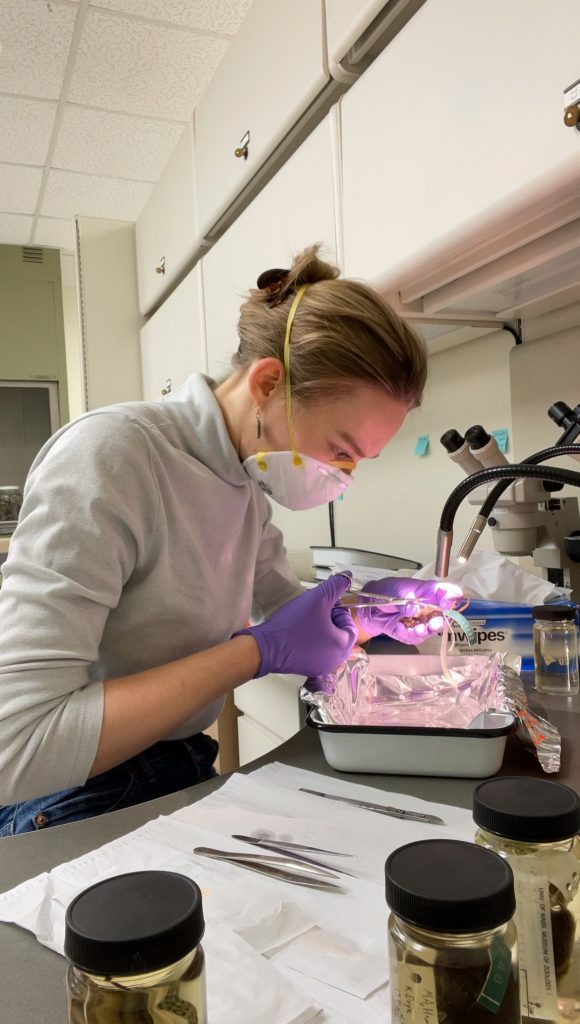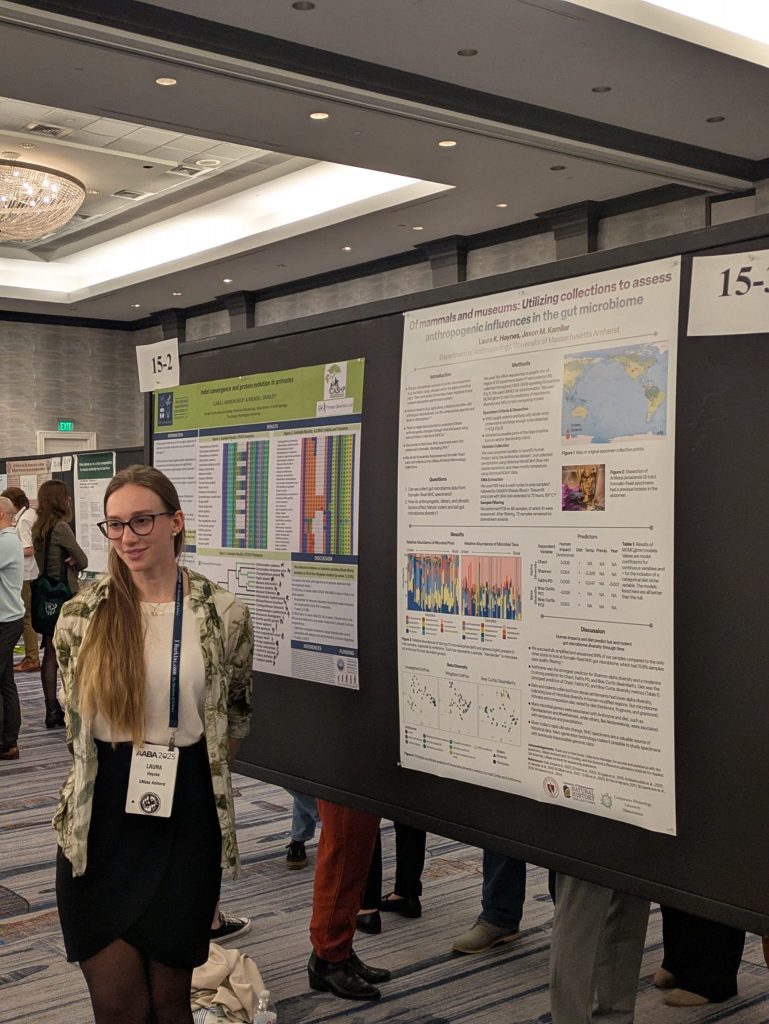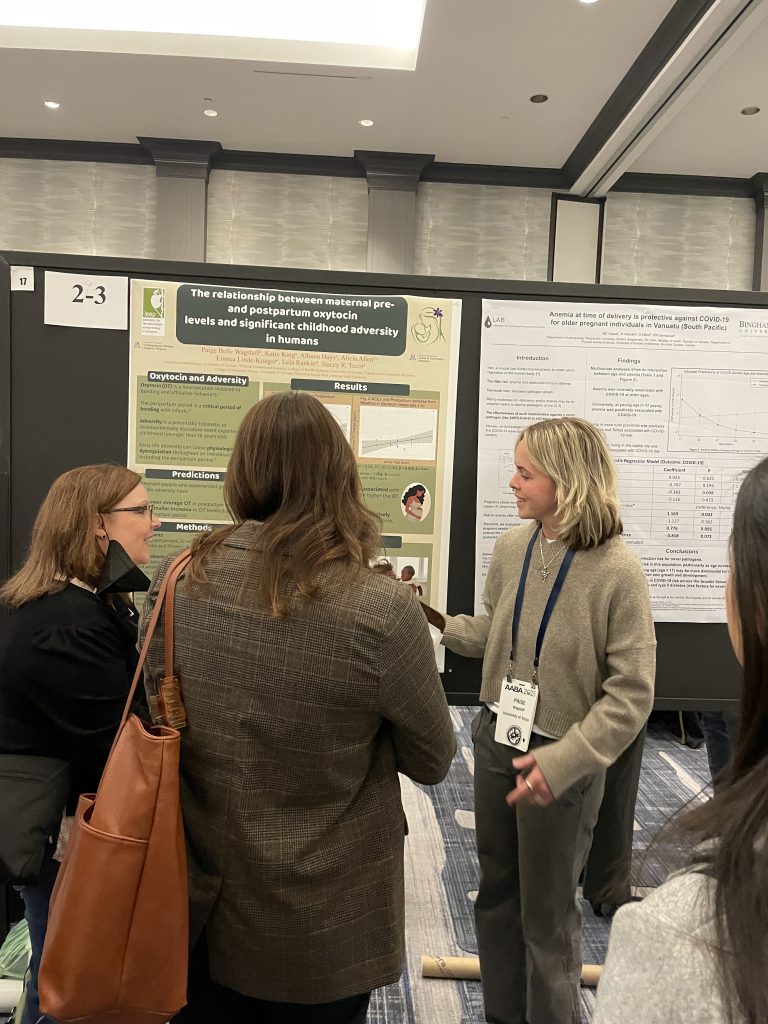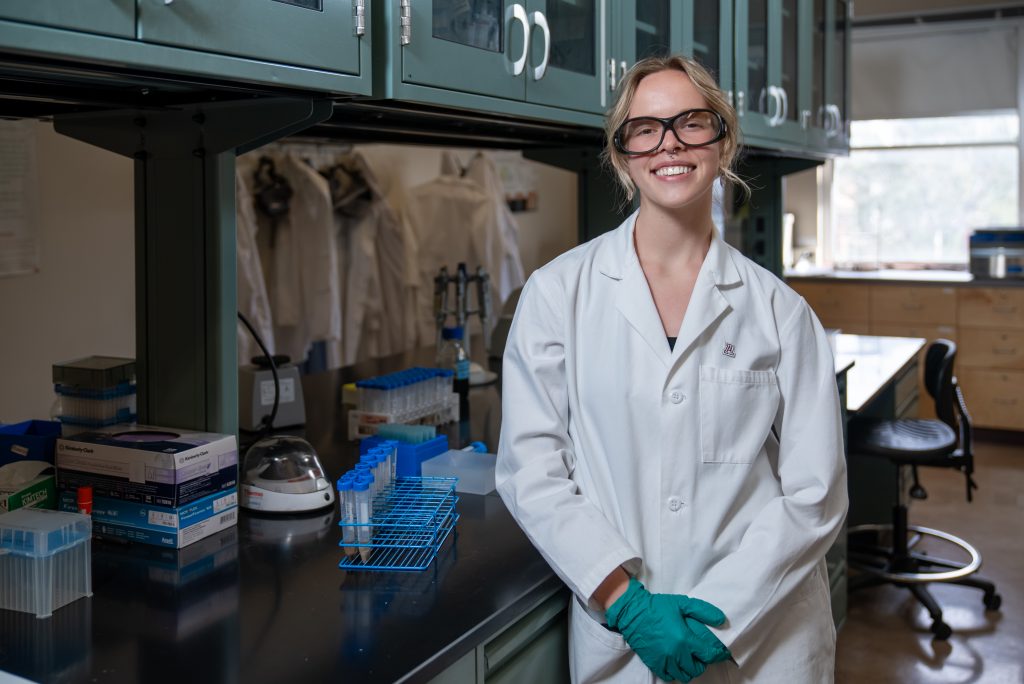The American Association of Biological Anthropologists (AABA) has long championed the achievements of emerging scholars in the field. Each year, the AABA Student Awards spotlight outstanding student research presented at the annual meeting, recognising innovative and rigorous work that reflects the future of biological anthropology. PeerJ is proud to highlight four winners from this year’s cohort—congratulations to all!
 Laura Haynes, UMass Amherst
Laura Haynes, UMass Amherst
Can you tell us a bit about yourself and your research interests?
I am a third year graduate student interested in primate ecology, microbiomes, social networks, and anthropogenic impacts. I am originally from Florida, where I developed a strong sense of connection to the environment because of its fragile and unique ecosystems.
What first interested you in this field of research?
I fell in love with anthropology in high school after reading a forensic anthropologist’s memoir, The Bone Woman. Years later, I began my undergraduate degree in Anthropology in 2018 at the University of Florida (UF). My background was in fine arts and my original research interests were in linguistics. Anthropology encompasses many disciplines and after I begrudgingly took a required Intro to Biological Anthropology course, I knew I had found my true niche. I fell in love with primates, humans’ closest relatives. Opportunistically, UF had also just hired a primatologist, Dr. Kim Valenta, who later became my research mentor. I ended up assisting her research on the ground in Madagascar, which was a foundational experience for my academic passions. I applied to graduate school knowing that I was interested in primates and microbiomes, however I did not truly study broader ecological concepts or microbes until my MA/PhD journey.
Can you briefly explain the research you presented at AABA?
I presented my Master’s research, which examined anthropogenic influences on preserved mammal gut microbiomes. The gut microbiome consists of all the microorganisms (e.g. bacteria, fungi, viruses) within the gastrointestinal tract and it performs many functions for the host, like nutrient absorption and immune system regulation. I dissected the large intestine from fluid-preserved bats and rodents stored at UMass Amherst Mammalogy collections. First, I established a novel protocol to extract DNA from these specimens because preservation methods (i.e. formalin-fixation) typically damage DNA. Then I amplified the V4 region of the 16s rRNA gene. During downstream analysis, I found that human landscape modifications as well as diet significantly influence historic bat and rodent microbial diversity. Mammals from more urbanized areas displayed lower microbial diversity. Our results underscore the potential of natural history collections to provide insights into the evolutionary and ecological dynamics of host-microbiome interactions in response to anthropogenic shifts over time.
What are your next steps? How will you continue to build on this research?
This summer I am conducting a pilot study in Uganda! I will be studying microbial transmission in a social network of Ruwenzori Angolan colobus monkeys at Lake Nabugabo. This is a shift from my natural history collections work, but relies on many of the same frameworks I presented in my master’s thesis. I aim to determine predictors of microbiome variation in social species and how this might fit into the big picture of the evolution of group-living. In the back of my mind, I am always thinking about extending my master’s research to examine preserved primate microbiomes, which have been collected and stored in museum collections for over a century!
Katherine Rickelton, UMass Amherst
My name is Katherine (Katie) Rickelton, and I am a 5th year PhD candidate in Molecular and Cellular Biology at the University of Massachusetts, Amherst. Can you tell us a bit about yourself and your research interests? As a scientist, I’ve always been really interested in research at the intersection of molecular biology and evolution. During my PhD, I’ve taken that general interest and applied it to questions about human evolution and how we’ve diverged from our closets primate relatives. In particular, I look at the evolution of the brain: humans are distinct among primates for their higher cognitive behaviors, including complex language production and problem-solving. To better understand why we’ve evolved so differently from our closest relatives, we employ genomic technologies to better understand these differences at the molecular level.
What first interested you in this field of research?
The evolution of cognition is highly complex, and it’s linked to a variety of other traits including the development of neurodegenerative diseases (at least, in humans). And so, even without considering other species, it’s relevant for us to better understand the basis for higher cognitive functions in order to also understand the origin of neurodegeneration – which is vital in the development of treatment strategies. Beyond this potential impact on human health, studying cognition across primates has helped so far to really highlight the fact that humans may not be as unique as we necessarily assume. Many of our closest relatives, including chimpanzees, regularly exhibit traits historically considered as cognitively complex (i.e. the use of tools). I think that this is a really important perspective that we’re learning more and more about by looking at non-human primates in greater detail, and can have potentially huge implications for our understandings of evolution, but also conservation efforts of many of these endangered species in the future.
Can you briefly explain the research you presented at AABA?
We analyzed gene expression differences in the cerebellum of 6 different primate species, including humans. The cerebellum is generally associated with functions related to motor control and balance, however a lot of recent research in humans has found this region of the brain to be involved in higher cognitive processes, namely language production. With this, we observed differences in the levels in which certain genes were expressed in this region of the brain across primate species, where generally humans appeared especially unique. We found that genes involved in metabolism and synaptic activity were found at high levels in human samples compared to other primates, and these cellular functions ultimately help in the production of higher cognitive phenotypes. We did also observe interesting trends in the non-human primates. For example, the siamang, which is an ape species, was found to uniquely express several genes related to vocalization behaviors, suggesting potentially some similarities to the ways in which human language has developed. And so while some aspects of cerebellar function may still be pretty unique in humans, some aspects of these more higher cognitive behaviors may be shared among our ape relatives.
What are your next steps?
How will you continue to build on this research? We are continuing to compare human and non-human primates at the level of different brain regions in order to assess what sorts of cellular processes and mechanisms may be responsible for the larger phenotypic differences (such as behavior). We also are working on several projects involving induced pluripotent stem cells (iPSCs), which offer a non-invasive method to study these species at the level of particular cell types. For example, we are working with human and chimpanzee iPSCs to study how neurons in each species may function differently. This sort of work will build on what we see at the level of the genome, connecting genetic differences with cellular phenotypes.
Paige Wagstaff, University of Arizona
Can you tell us a bit about yourself and your research interests?
My name is Paige Wagstaff and I am a current undergraduate at the University of Arizona. Soon, I am graduating from the University of Arizona and receiving my Bachelor of Science in Biological Anthropology with a minor in Nutritional Sciences. I have been a research assistant in the Laboratory for the Evolutionary Endocrinology of Primates (LEEP) these past two years and excited to continue my work with LEEP in Madagascar this summer. I am joining LEEP in Ranomafana National Park in Madagascar where we will be studying the endocrinology of red-bellied lemurs. This will be my first time in the field and it’s been a dream of mine for a while now. During my time as a research assistant I have grown a keen interest in how early life experiences affect later health and physiological outcomes in humans and non-human primates. I hope to continue researching and in the future pursuing graduate school studying non-human primates.
What first interested you in this field of research?
During my sophomore year of my undergrad I took a human-evolution based class and I fell in love with primatology. This made me curious about opportunities to work in research and get exposure to what being a primatologist may be like. I reached out to Dr. Tecot the LEEP director at the University of Arizona and applied to be a research intern in her lab. Thankfully she took a chance on me and from there I was shown the way around a lab and started to study hormones. In LEEP we study oxytocin and its role in mother-infant bonding, I knew that I wanted to discover more about it and now had the opportunity to do it.
Can you briefly explain the research you presented at AABA? 
At AABA I presented my senior thesis research investigating the relationship of maternal peripartum oxytocin levels and early life adversity experienced by the mothers in their childhoods. The peripartum is also a crucial time period of mother-infant bonding essential for both the infant and parent. Adverse events can cause physiological dysregulation throughout an individual’s life and to what extent it may affect new mothers oxytocin levels is what we aimed to answer. We predicted that those with higher adverse events would have lower levels of oxytocin during the peripartum period and a smaller increase of oxytocin from pre to postpartum. We found differing results however, those who experienced higher adversity in childhood had higher oxytocin levels and a larger increase in oxytocin from pre to postpartum. This result may reflect resilience in these mothers if higher oxytocin acts as a compensatory mechanism for lower oxytocin receptor functioning.
What are your next steps? How will you continue to build on this research?
I am currently looking into future PhD programs within biological anthropology and hoping in the meantime to conduct field work or work in a lab. Building on our research our results may give insight into possible use of intranasal oxytocin on mothers who have experienced higher adversity in their childhood. Understanding the effects of early life experience especially in mothers can offer insight into possible care necessary to facilitate mother-infant bonding. We are also looking into specific adverse experiences and questioning if specific adverse events have a greater effect on oxytocin profiles. In the future I’d be interested to study this within non-human primates to see if there are any evolutionary implications of early life adversity on oxytocin in parenthood.
Melissa Zarate, Boston University
Can you tell us a bit about yourself and your research interests?
I obtained a B.S. in biology and environmental studies from Denison University in 2016, and a M.S. in Biology from Boston University in 2020. I have always been interested in how species interact with their environment, especially in environments that are heavily influenced by human activity. I take an interdisciplinary approach to primate conservation by understanding their evolution in their habitats at a molecular level. The main objective of my Ph.D. dissertation is to understand how the critically endangered yellow-tailed woolly monkey (Lagothrix flavicauda) is adapted to its high-elevation environment, population structure across its range, and how human-induced alterations to landscape influence this structure.
What first interested you in this field of research?
Going into college, I was initially interested in becoming a wildlife veterinarian, as I wanted a career that would allow me to travel and help animals at the same time. However, throughout my course work in my undergrad, I became increasingly interested in ecology and evolution. When I took on environmental studies as a minor, which was a very broad field at my liberal arts school, I took a few classes in anthropology, such as human, indigenous, and environmental rights and humans and nature. These classes inspired me to understand more about human’s connection and interaction with the environment, and how that impacts endangered species. Going forward, I never actually expected to be in the field of biological anthropology (nor did I know what it was during my undergrad), but when I started studying the yellow-tailed woolly monkey in my masters and taking classes crossed between the bio anth and biology departments, I became interested in how all aspects of anthropology intersect in different ways that could answer some of the questions I have about primate conservation.
Can you briefly explain the research you presented at AABA?
I presented a new, high coverage reference mitochondrial genome for the yellow-tailed woolly monkey. This will be the first published reference for the species, and one of the few mitochondrial genome references created using noninvasively collected fecal samples and Nanopore sequencing. It was important to me to see if this could be done with ONT sequencing, as the portable size of the MinION sequencer allows for use in the field, eliminating the need to obtain export permits, and building capacity for genetics work in primate-inhabiting countries. Additionally, I used mutation rations within the mitochondrial genome of this and other atelin species to make inferences about natural selection acting on the mitochondrial genome to make the species well-adapted for high-elevation conditions, finding differential purifying selection within the yellow-tailed woolly monkey genome.
What are your next steps? How will you continue to build on this research?
I am currently working on using this reference to map the ONT sequencing reads that I have obtained from dozens of fecal samples I collected from the yellow-tailed woolly monkey in Peru with the purpose of quantifying variation within and between different populations. I am also quantifying the landscape to understand how it influences this differentiation and variation. I am also working to use this data to understand the timing of divergence of a seemingly isolated population over 200km south of the species’ previously known range, and why this population is geographically isolated from others. I want to continue to build upon this project, using various methods to conduct molecular analyses for this and other endangered species.


